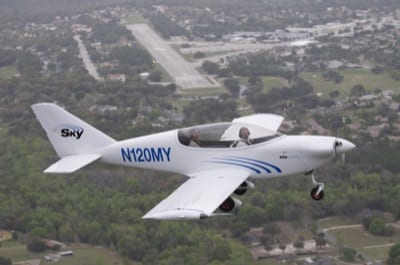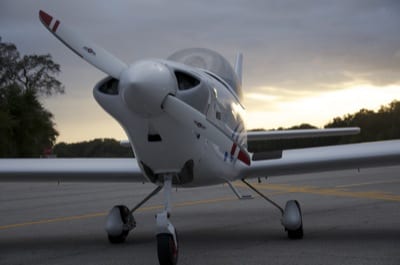What do you get when you create an aircraft that is inspired by the Reno Air Races and the P-51 Mustang and wrap it up in a package that fits neatly in the Light Sport Aircraft category? You get the MySky-1, a tandem, low-wing built by MySky Aircraft in Spruce Creek, Fla.
The MS-1 debuted at the U.S. Sport Aviation Expo in January. Judging by the reaction from the crowds, the design is the hit.
“Is it a kit?” one man asked, tentatively running his hand along the leading edge of the wing.
“It’s a ready to fly model,” replied David McCartney, director of operations for AeroController, the marketing company representing MySky at the show.
“It looks too sexy to be an LSA,” another visitor said. McCartney just smiled.
Sex and the MySky seem to go hand in hand. The write-up on the MySky webpage plays up the sensuous lines of the airplane: “The nimble MS-1 is responding to every nuance of your touch. A warm smile spreads over your face. Just when you thought the thrill of flying a true sport airplane was out of reach, you discovered the ultimate LSA. The marvelous MS-1. Welcome to the MySky adventure.”
Are we still talking about airplanes here?
Definitely, said McCartney, who noted that the MS-1 is one of the few aircraft specifically designed to meet the LSA category.
The airplane on display at Sebring was the flying prototype. The production airplane’s design is in the final stages of design perfection, according to McCartney.
“It is 99.9% done,” he said. “When we are 100% happy with it, we know other people will be happy with it.”
The prototype airplane is fiberglass with carbon fiber spar straps. According to the designers, they are experimenting with more carbon parts, and there is a good chance that the production aircraft will have carbon control surfaces.
The MS-1 was designed to be easy enough to fly for the training market, but sporty enough for pilots who have been flying for decades who “want something akin to a flying Porsche, yet docile enough for the fledgling aviator,” he said.
The LSA has a stall speed of 38 knots with full flaps and an approach speed of 65 knots. “You really have to do some serious messing up to lose 30 knots on final,” McCartney said. “If you trim it up, add full flaps, pull the throttle all the way back, and point it to the runway, the airplane practically lands itself.”
The panel is equipped for daytime, VFR flight using the GLX-glass panel in both the front and rear cockpits if the customer desires.
The MS-1 can also be outfitted with a two-axis autopilot.
The display MS-1 had leather seats and a rear-attach canopy because it was used for flight testing. The production models will have a side flip canopy design, which should make it easier to open and close when you are sitting in the cockpit.
The LSA is controlled with a side-stick. The throttle is also on the side.
“You feel like a fighter pilot when you sit in it, “ said McCartney “The combination of the side stick and throttle makes it just so much fun to fly.”
Wing span is 30 feet. For comparison, the wingspan of the Cessna 172 is approximately 37 feet.
The flaps on the MS-1 have extrusions known as gurneys, which give it greater stability at slower airspeeds.
On the front of the MS-1 hangs a ground-adjustable Sensenich composite propeller. The engine is a 120-hp Jabiru 3300, which burns an economical 4.5 gallons per hour in cruise flight, according to McCartney, who noted it cruises at 120 knots and can burn either 100LL or mogas. “The hundred dollar hamburger just got that much cheaper,” he said.
The cost savings extend to maintenance, McCartney said, pointing to the wheel pants.
“The wheel pants are an open World War I-inspired design that covers the front and back of the tire but leaves the sides open,” he said. “We knew we could make the airplane less expensive to operate if we made it easier for the mechanic to work on. It can take a mechanic about an hour to take off a wheel pant. That can be $65 an hour and that gets expensive quickly. You’ve already spent over $300 to take off the wheel pants and the mechanic hasn’t even touched the tires yet. With this design you get the same aerodynamic efficiency as a full wheel pants but you are able to check your brakes and tire pressure without removing the pants.”
In addition to good looks, the MS-1 has the performance that pilots crave.
“It’s a lot fun to fly,” said McCartney. “I do competition aerobatics in a Pitts, and this airplane is just as much fun. Pilots with 10,000 hours are going to enjoy it, pilots with 10 hours are going to enjoy it.”
It is sure to turn heads on the ramp, he added.
“It doesn’t look like a typical LSA ,” he said. “After you’ve landed, people will turn their heads and remark ‘that’s a cool airplane’. Not every LSA can do that.”
The base price for the MySky is $124,500. Production is slated to begin next year.
For more information: MySky.aero




